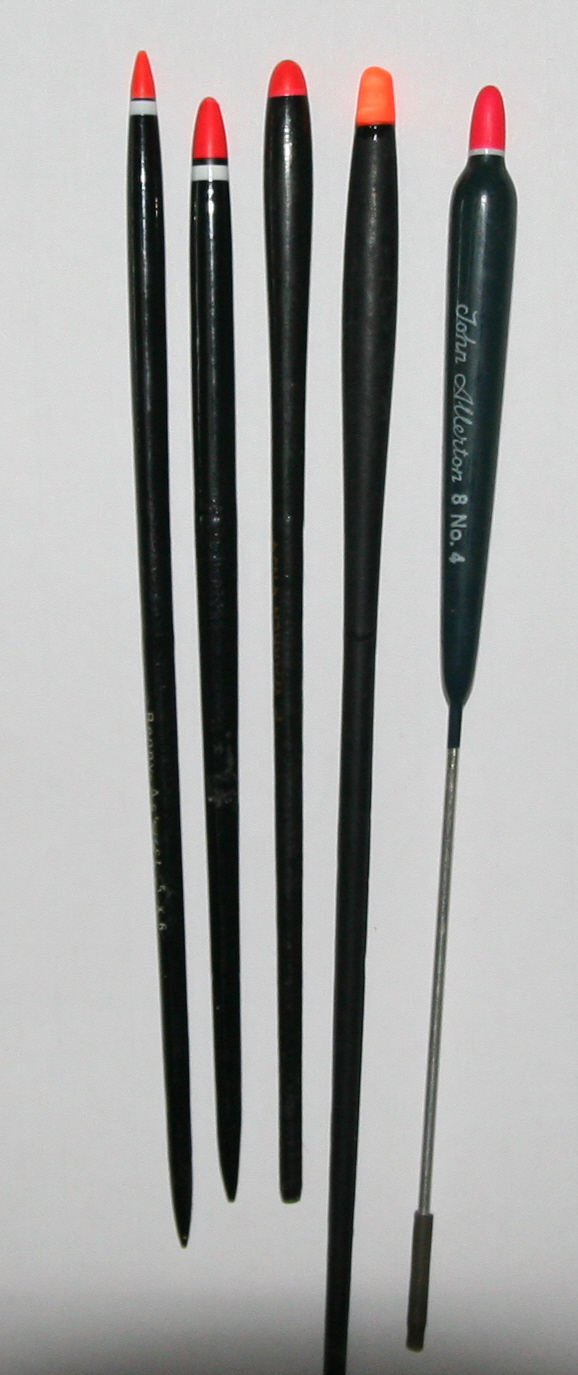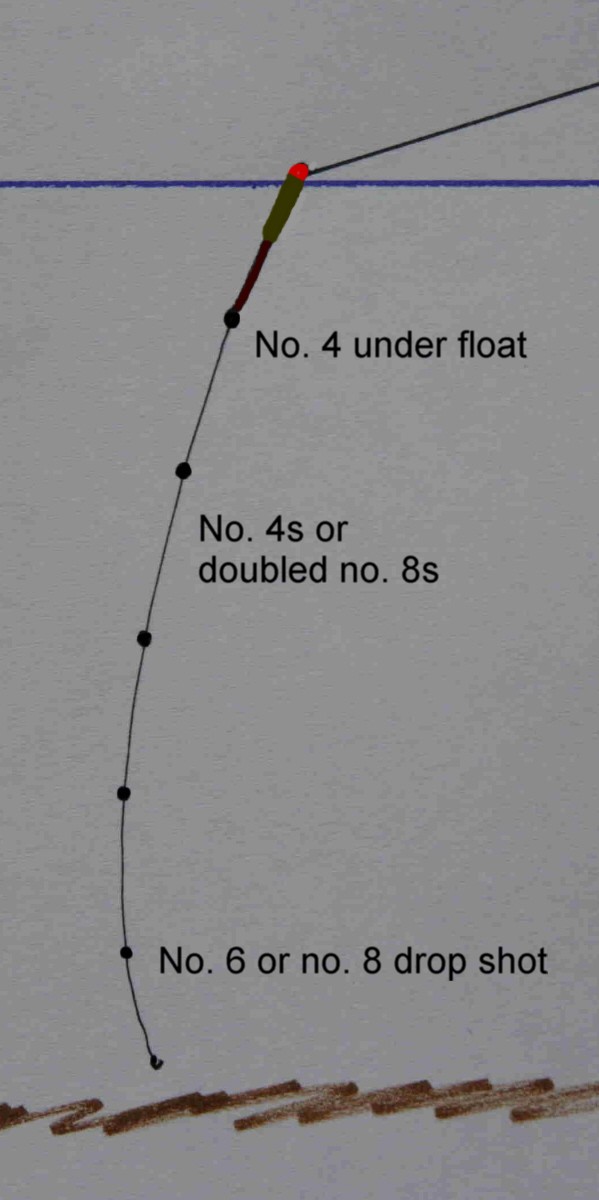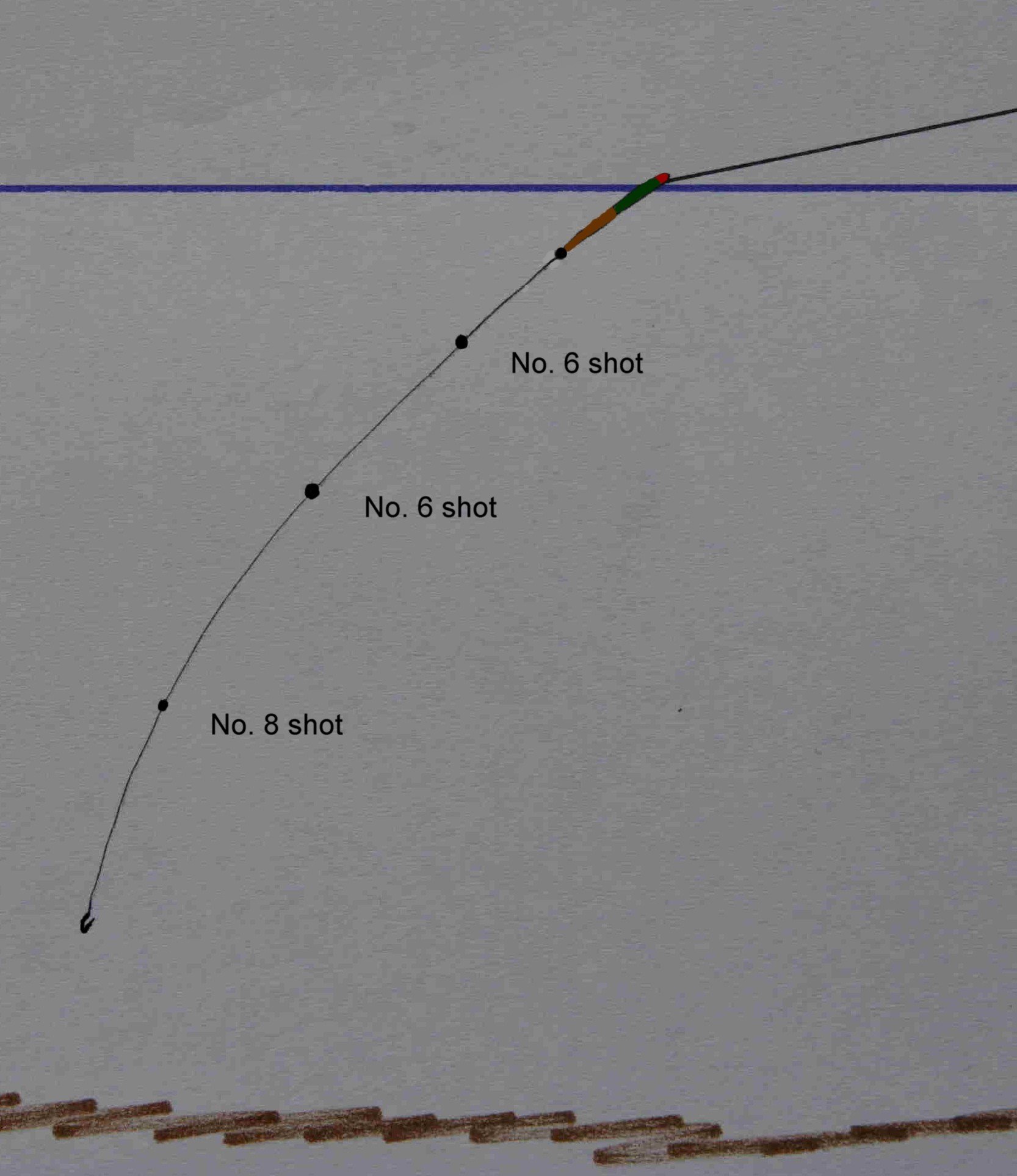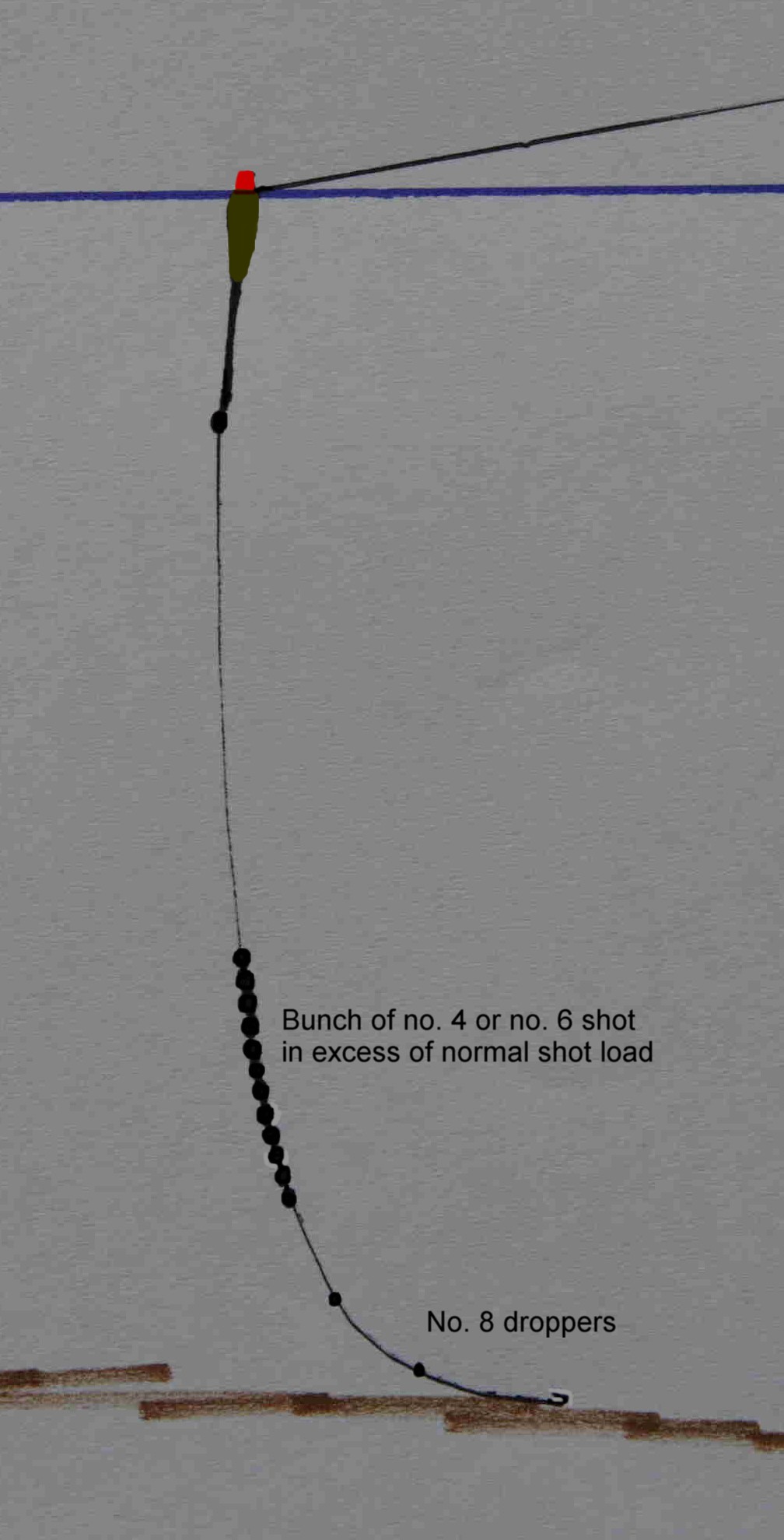The stick float offers a degree of delicacy over other trotting rigs. It takes less shot load with standard stick floats taking from 3 no.4 to 8 no. 4 shot as a load. It also offers the means to register delicate bites as well as present a small bait on the drop. Although often misused, in the right hands it is a deadly and enjoyable method for roach, dace and chub.
The original stick floats developed by Benny Ashurst evolved from delicate cane and balsa canal floats used to present casters across the tough Lancashire canals. When the Lancashire aces transferred their attentions to the artificially warmed Trent, they found that it was possible to catch the small and prolific Trent roach by fishing on the drop as the roach shoals moved up in the water. This proved more effective than the more conventional heavier trotting gear of the locals.
In time, other anglers developed variations to include steel wire and alloy wire stems instead of cane, and other variations around the shape of the body and tip as well as stem materials such as plastic and lignum wood have all been tried.

Perhaps the biggest problem nowadays is finding good stick floats. At one time, many top anglers developed ranges of floats bearing their names such as Benny and Kevin Ashurst, Ivan Marks, Billy Lane, Pete Warren, John Dean and John Allerton to name but a few. The modern popularity of stillwater commercials, carp fishing and legering on rivers has reduced the demand for this type of float so you may have to search around to find good stick floats or make your own.
(Picture right, L-R floats by Ashurst, Marks, Warren, Dean, and Allerton)A good delicate stick float needs the other tackle to match the float. That means a lightweight ‘tippy’ match rod, a small fixed spool reel (the Mitchell Match is still the finest and quickest but a ‘2500’ size reel from Daiwa or Shimano will do the trick – just ensure that your forefinger easily reaches the spool lip) a light floating line (sprayed with silicone line floatant) , ideally 2lbs, and a selection of small shot (nowadays lead shot in no 8, 9 & 10).
Types of stick float
Traditional cane base – this is the original and best for on the drop fishing. A perfectly balanced example can be thrown through the air like a dart; if it dives or wobbles, it won’t fish properly.
Plastic stem based – the John Dean examples remain the best stick floats of all time – if you can find them! There are some (Drennan) with very heavy bases – these cast well but lack the delicate presentation possible with the Dean examples.
Alloy stemmed – John Allerton developed these for the Trent and they are ideal for over-shotting and holding back. These are a good choice for standard trotting.
There are also some modern ‘hybrid’ sticks that are bulkier than traditional sticks but more suited to boily water.
Choose the size of stick float based on the depth; work on the basis of one no. 4 per foot of depth for standard trotting and less than this for on the drop – either one no. 6 or one no. 8 per foot of depth. It can be seen from this that stick floats are ideal in relatively shallow water – from about three feet to six feet of water, and that in much deeper swims it may be better to switch to another type of float although a stick float can be made to work in as much as 12 feet of water.
Pointed tips are good for bite registration, rounded, thicker tips for holding up in boily water, and floats with a shoulder at the tip good for over-shotting and holding back.
Consider also the conditions and whether they allow you good or excellent control of the float. That usually means a favourable and not too strong wing, ideally off your back or up stream. Facing or strong downstream winds can be a nightmare especially if you try to fish at any sort of range. Although many people fish stick floats at comparatively short range – up to 10 yards from the bank – with the right stick floats – the John Dean ones or the better lignum sticks – and conditions – a wind off your back and a swim about five feet deep – it is possible to fish much further out provided you keep within catapult range which is about twenty to twenty five yards when feeding maggots, casters and hemp.
Attaching the float to the line
It is important to select snugly fitting silicone float rubbers for the top and bottom of the float. The top rubber should be about 3-4mm long and positioned immediately below the tip colour. The bottom one should be 25mm long and position so that about 2mm extends beyond the end of the float. You will need float rubber in various sizes from about 2mm to 5mm to cater for different types of float.
Basic shotting patterns
 The original basic stick float rigs were to space either no. 4 or no. 6 shot at about 1 foot intervals with a shot one size below, i.e. a no. 6 with no. 4 or a no. 8 with no. 6, as a final ‘drop’ shot about a foot from the hook. This pattern still works though the modern non-toxic tin shot behave differently from the original lead shot.
The original basic stick float rigs were to space either no. 4 or no. 6 shot at about 1 foot intervals with a shot one size below, i.e. a no. 6 with no. 4 or a no. 8 with no. 6, as a final ‘drop’ shot about a foot from the hook. This pattern still works though the modern non-toxic tin shot behave differently from the original lead shot.
To overcome this deficiency, many top stick float anglers persevere with lead shot in the legal sizes of 8, 9 and 10, doubling them up to get the equivalent of no. 4 and 6 etc. This does work well, and you have the option of splitting the bunched shot or bunching more shot together as required.
 Using very light floats combined with strung out dust shot is the best way to fish on the drop for dace and roach. It requires skill and concentration combined with careful and very regular feeding (more than once a cast) of maggots or casters. Take care to lay the rig on the water in a straight line downstream so that the drop is under control.
Using very light floats combined with strung out dust shot is the best way to fish on the drop for dace and roach. It requires skill and concentration combined with careful and very regular feeding (more than once a cast) of maggots or casters. Take care to lay the rig on the water in a straight line downstream so that the drop is under control.
For standard stick float work, many anglers put one shot immediately under the float. Make sure this is only a no. 8, 6 or 4.
 Bulk and droppers
Bulk and droppers
Whilst standard sticks work best with the strung out or ‘shirt-button’ pattern, alloy stemmed floats often work best with a bulk of three to 6 no.4 shot about two or three feet from the hook with smaller shot – no. 8s – strung out below the bulk. This is a good set-up for faster and boilier swims.
Over-shotting
 There are times when you want to slow a stick float right down, much more than the usual controlled trot. If you attempt to do this with a conventionally shotted float, it will tend to rise out of the water. To stop this happening it is possible to carefully add more shot or ‘over-shot’ it so that the extra shot hold the float and bait down in the water.
There are times when you want to slow a stick float right down, much more than the usual controlled trot. If you attempt to do this with a conventionally shotted float, it will tend to rise out of the water. To stop this happening it is possible to carefully add more shot or ‘over-shot’ it so that the extra shot hold the float and bait down in the water.
Where you add the shot to the rig is down to you but generally it will be well down the line. This is probably the best circumstance to consider using a centre-pin reel especially as you will most probably be fishing close in. It is easily possible to achieve the same with an open-faced fixed spool reel though with an entirely different style of releasing line.
Whereas with a ‘pin you hold the rod more or less stationary and control the rate that the spool spins to retard the float, doing the same with a fixed-spool means NOT releasing the line and moving the rod is a very controlled manner. When the rod has reached its furthest point then release some line and sweep the rod back to repeat the process.
You will find that with careful feeding, you develop a ‘killing’ ground of about a yard or two and that is the area to concentrate on getting the bait presentation absolutely perfect. Certainly if you find the fish scattered all over the swim then consider whether you feeding is accurate and concentrated enough. In fishing a stick float in this manner you may need to adjust the depth so that you can fish deeper than the actual depth to just trickle the bait along the bottom.
Feeding and practice
Very regular and controlled feeding is the key to stick float success. Aim to feed EVERY cast. As a skill using a stick float does take a lot of practice and if you ever get a chance to see a real ‘ace’ then take it.
About the Rigs Page
- The Rigs Page is a library of features to illustrate all those rigs that will be useful to both beginners and experienced anglers.
- The rigs can be extremely simple and well known, or very complicated and little known, it doesn’t matter providing they make some kind of sense and have a really practical application.
- It could be a standard running leger rig that a beginner will appreciate seeing in pictures, or a very complicated anti-eject carp rig that the experienced carp angler would like to see.
- If you wish to contribute a rig to this section please remember that the emphasis is on illustration rather than words. Good line drawings are fine in the absence of photographs. Please send to graham@fishingmagic.com










